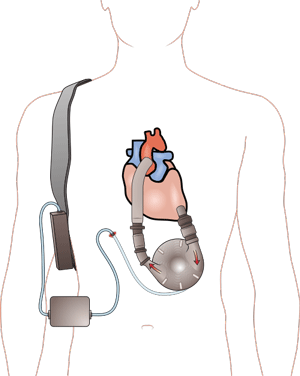
Surgeons created the new heart using ventricular assist devices (shown above).
What’s the News: Checking a person’s pulse is often the first thing you do to see if they’re still alive. But a new artificial heart, developed this past spring, will complicate this common diagnosis: Researchers at the Texas Heart Institute have now created a fully functioning artificial heart that uses rotors to circulate blood instead of contractions, like a natural heart. How the Heck:
To create their novel heart, surgeons Billy Cohn and Bud Frazier combined two ventricular assist devices, which typically aid failing hearts pump blood. Rather than mimicking the real organ like other artificial hearts, the contraption uses rotors to circulate blood throughout your body, non-stop.
Cohn and Frazier successfully tested their pulseless heart in 38 calves before moving on to a human. "By every metric we have to analyze patients, she's not living," Cohn said of an 8-month-old calf. "But here you can see she's a vigorous, happy, playful calf licking my hand."
In March, they decided to test their device in Craig Lewis, who was dying of amyloidosis, a condition in which protein deposits can clog organs and shut them down. When Lewis agreed to the heart replacement, he had about 12 hours left to live, according to his doctors (via NPR).
Lewis survived a month with his new humming heart but then died of liver and kidney complications brought on by his disease.
What’s the Context:
The technology for the device isn’t entirely new: ventricular assist devices have been around since the 1980s. Last year, former vice-president Dick Cheney replaced his left ventricle with the latest model, the HeartMate II (the same model put in Lewis’ chest).
While the components have been around awhile, this is the first time anyone has combined two of them to completely replace a heart.
The surgeons believe their device is an improvement over normal heart pumps. In particular, the pulseless heart is likely to last longer because it only has two moving parts (the rotors). “These pumps don't wear out," Frazier told NPR.
The Future Holds: Before they can bring the pulseless heart to a hospital near you, Cohn and Frazier will need to settle on a design, partner with a manufacturer, and get approval for commercial development by the Food and Drug Administration. (via NPR
)
Image: Wikimedia Commons/Madhero88













